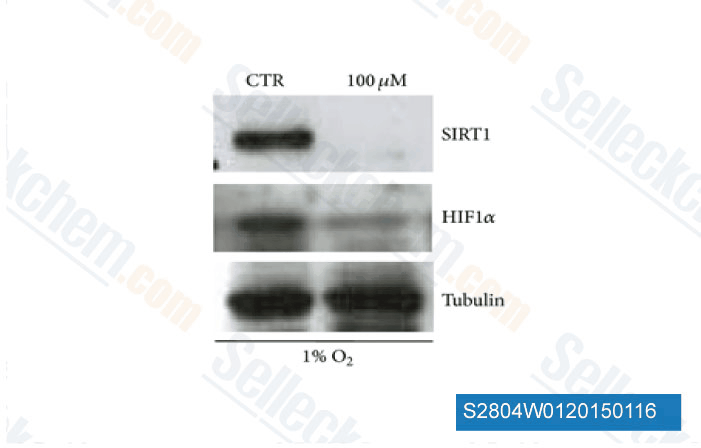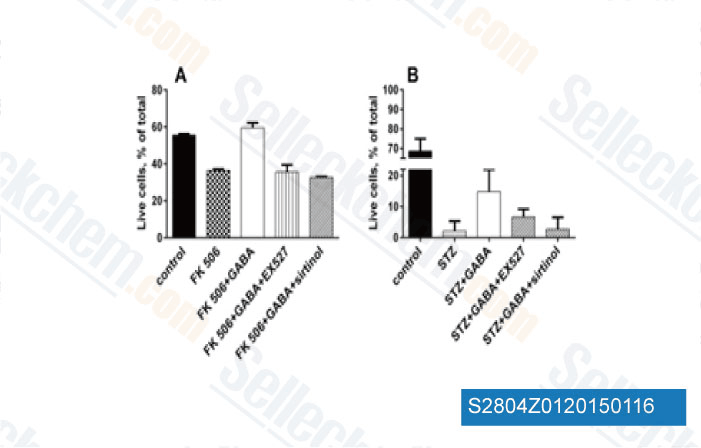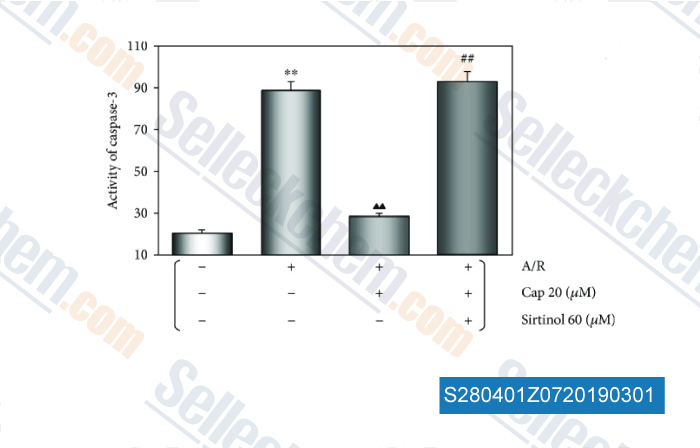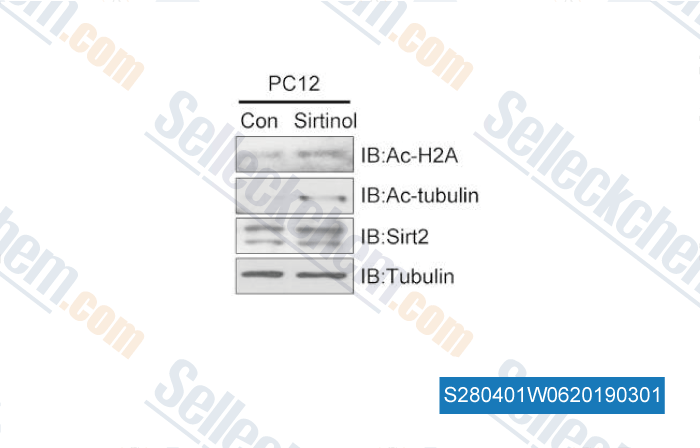|
Toll Free: (877) 796-6397 -- USA and Canada only -- |
Fax: +1-832-582-8590 Orders: +1-832-582-8158 |
Tech Support: +1-832-582-8158 Ext:3 Please provide your Order Number in the email. |
Technical Data
| Formula | C26H22N2O2 |
||||||
| Molecular Weight | 394.47 | CAS No. | 410536-97-9 | ||||
| Solubility (25°C)* | In vitro | DMSO | 23 mg/mL (58.3 mM) | ||||
| Water | Insoluble | ||||||
| Ethanol | Insoluble | ||||||
| In vivo (Add solvents to the product individually and in order) |
|
||||||
|
* <1 mg/ml means slightly soluble or insoluble. * Please note that Selleck tests the solubility of all compounds in-house, and the actual solubility may differ slightly from published values. This is normal and is due to slight batch-to-batch variations. * Room temperature shipping (Stability testing shows this product can be shipped without any cooling measures.) |
|||||||
Preparing Stock Solutions
Biological Activity
| Description | Sirtinol is a specific SIRT1 and SIRT2 inhibitor with IC50 of 131 μM and 38 μM in cell-free assays, respectively. | ||||
|---|---|---|---|---|---|
| Targets |
|
||||
| In vitro | Sirtinol potently inhibits recombinant yeast Sir2p activity in vitro with IC50 of 68 μM. Unlike TSA, Sirtinol has shown no effect on human HDAC1, indicating that it is a selective sirtuin inhibitor. Unlike TSA, treatment of human primary fibroblasts with Sirtinol does not cause global changes in acetylation of histones and tubulin, nor does it induce a morphological change in the HeLa tumor cell line. [1] Sirtinol treatment at 100 μM for 24 hours causes a sustained growth arrest in MCF-7 and H1299 cells for up to 9 days after Sirtinol withdrawal. Sirtinol treatment induces increased SA-β-gal activity and expression of PAI-1 in both MCF-7 and H1299 cells, more potently than Splitomicin. Sirtinol inhibits colony formation at concentrations of 33 μM and higher in MCF-7 and H1299 cells, more effectively compared with Splitomicin. Sirtinol treatment (100 μM) significantly attenuates both basal and EGF- or IGF-I-stimulated phosphorylation of ERK, JNK/SAPK and p38 MAPK in MCF-7 and H1299 cells. Sirtinol blocks the basal and EGF-stimulated activation of Ras. Consistent, basal and EGF- or IGF-I-stimulated phosphorylation of Raf-1, MEK, SEK1/MKK4 and MKK7 is attenuated in Sirtinol-treated cells. [3] Inhibition of Sirt1 by Sirtinol enhances UV- and H2O2-induced p53 acetylation to enhance cell death in cultured skin keratinocytes. [6] Blocking of Sirt1 by Sirtinol treatment results in a significant inhibition in the growth and viability of human PCa cells while having no effect on normal prostate epithelial cells. [7] | ||||
| In vivo | Administration of Sirtinol at 1 mg/kg attenuates pro-inflammatory cytokine production and protects against hepatic injury following trauma-hemorrhage in male Sprague-Dawley rats. [4] | ||||
| Features | Sirtinol does not inhibit class I and class II HDACs. |
Protocol (from reference)
| Kinase Assay: |
|
|---|---|
| Cell Assay: |
|
| Animal Study: |
|
References
Customer Product Validation

-
Data from [Data independently produced by Biomed Res Int, 2014, 783459]

-
Data from [Data independently produced by Biochem Biophys Res Commun, 2014, 452(3), 649-54]

-
Data from [Data independently produced by , , Oxid Med Cell Longev, 2017, 2017:1035702]

-
Data from [Data independently produced by , , Sci Rep, 2016, 6:21857]
Selleck's Sirtinol has been cited by 48 publications
| α-Mangostin Inhibited M1 Polarization of Macrophages/Monocytes in Antigen-Induced Arthritis Mice by Up-Regulating Silent Information Regulator 1 and Peroxisome Proliferators-Activated Receptor γ Simultaneously [ Drug Des Devel Ther, 2023, 17:563-577] | PubMed: 36860800 |
| A COMPARATIVE ANALYSIS TO DETERMINE THE OPTIMUM HISTONE DEACETYLASE INHIBITORS AND ADMINISTRATION ROUTE FOR IMPROVING SURVIVAL AND ORGAN INJURY IN RATS AFTER HEMORRHAGIC SHOCK [ Shock, 2023, 60(1):75-83] | PubMed: 37141162 |
| Protective effect of HDACIs in improves survival and organ injury after CLP-induced sepsis [ Surg Open Sci, 2023, 12:35-42] | PubMed: 36936452 |
| Epigenetic alterations of CXCL5 in Cr(VI)-induced carcinogenesis [ Sci Total Environ, 2022, 838(Pt 1):155713] | PubMed: 35660107 |
| Targeting the MITF/APAF-1 axis as salvage therapy for MAPK inhibitors in resistant melanoma [ Cell Rep, 2022, 41(6):111601] | PubMed: 36351409 |
| Nicotinamide improves in vitro lens regeneration in a mouse capsular bag model [ Stem Cell Res Ther, 2022, 13(1):198] | PubMed: 35550648 |
| Effects of Hst3p inhibition in <i>Candida albicans</i>: a genome-wide H3K56 acetylation analysis [ Front Cell Infect Microbiol, 2022, 12:1031814] | PubMed: 36389164 |
| Nicotinamide n-Oxide Attenuates HSV-1-Induced Microglial Inflammation through Sirtuin-1/NF-κB Signaling [ Int J Mol Sci, 2022, 23(24)16085] | PubMed: 36555725 |
| Arylamine N-Acetyltransferase 1 Activity is Regulated by the Protein Acetylation Status [ Front Pharmacol, 2022, 13:797469] | PubMed: 35153780 |
| Arylamine N-Acetyltransferase 1 Activity is Regulated by the Protein Acetylation Status [ Front Pharmacol, 2022, 13:797469] | PubMed: 35153780 |
RETURN POLICY
Selleck Chemical’s Unconditional Return Policy ensures a smooth online shopping experience for our customers. If you are in any way unsatisfied with your purchase, you may return any item(s) within 7 days of receiving it. In the event of product quality issues, either protocol related or product related problems, you may return any item(s) within 365 days from the original purchase date. Please follow the instructions below when returning products.
SHIPPING AND STORAGE
Selleck products are transported at room temperature. If you receive the product at room temperature, please rest assured, the Selleck Quality Inspection Department has conducted experiments to verify that the normal temperature placement of one month will not affect the biological activity of powder products. After collecting, please store the product according to the requirements described in the datasheet. Most Selleck products are stable under the recommended conditions.
NOT FOR HUMAN, VETERINARY DIAGNOSTIC OR THERAPEUTIC USE.
